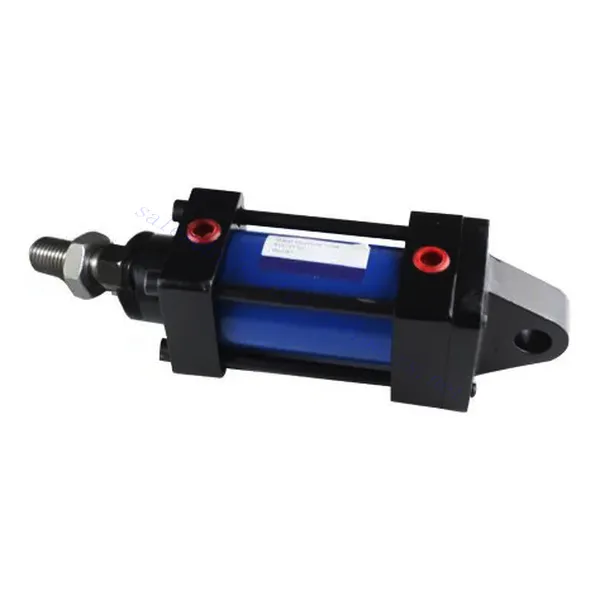Siłownik hydrauliczny z lekkim tłoczyskiem typu monoauralnego CA
Jako jeden z producentów, dostawców i eksporterów produktów mechanicznych, oferujemy cylindry hydrauliczne i wiele innych produktów.
Prosimy o kontakt w celu uzyskania szczegółowych informacji.
Poczta:sales@hydraulic-cylinders.net
Producent dostawca eksporter siłowników hydraulicznych.
Siłownik hydrauliczny z lekkim tłoczyskiem typu monoauralnego CA
The CA monoaural type light rod hydraulic cylinder is an advanced hydraulic cylinder designed to optimize accuracy and efficiency for a variety of industrial applications. With its monophonic design and light pole construction, this cylinder offers superior performance, reliability, and ease of use.
The Main Features And Advantages Of The Light Rod Hydraulic Cylinder:
Monophonic Design: The light rod hydraulic cylinder adopts a monophonic design with a single rod extending from one end. This design provides compact and simplified installation, making it suitable for limited-space applications.
Light Rod Structure: Light rod structure is made of lightweight aluminum or composite materials. This reduces overall weight, enables faster operation, reduces energy consumption, and increases efficiency.
Improved Accuracy: CA monoaural type light rod hydraulic cylinder ensures precise linear motion control. It provides accurate positioning and smooth motion, making it ideal for applications that require high precision, such as robotics, automation systems, and packaging machinery.
Compact And Space-saving: Due to its compact size, the cylinder is ideal for installation where space is limited. Its small footprint makes integrating into machinery and systems easy without compromising performance.

CA Monoaural Type Light Rod Hydraulic Cylinder Parameter:

Siłownik hydrauliczny z lekkim tłoczyskiem typu monoauralnego CA Usage Method:
Installation: Install the cylinder safely using appropriate fasteners to ensure stability and proper alignment.
Hydraulic Connection: Connect the hydraulic line to the specified port on the cylinder. Make sure joints are tight to prevent leaks.
Power Supply: Connect the cylinder to a reliable hydraulic power source, such as a pump or power unit.
Test And Adjust: Thoroughly check all connections and ensure their safety before operation—test cylinder movement by starting the hydraulic system and verifying smooth, linear motion.
How To Take Apart A Hydraulic Cylinder?
Taking apart a hydraulic cylinder requires careful handling and adherence to proper disassembly procedures. Here’s a general guide on how to disassemble a hydraulic cylinder:
- Safety Precautions:
- Ensure that the hydraulic system is depressurized and that the cylinder has no residual pressure. Follow proper lock-out/tag-out procedures to prevent accidental activation of the system.
- Wear appropriate personal protective equipment (PPE), such as gloves and safety glasses, to protect yourself from hydraulic fluid and potential hazards.
- Cylinder Removal:
- Disconnect the hydraulic lines connected to the cylinder, ensuring any residual fluid is adequately contained.
- Remove any fasteners or mounting brackets to free the cylinder if the cylinder is mounted or secured to other components.
- Carefully lift and remove the cylinder from its mounting position, taking care not to damage or strain any attached hoses or fittings.
- Inspection and Documentation:
- Thoroughly examine the exterior of the cylinder for any signs of damage, leaks, or excessive wear. Document any observations or issues for future reference.
- Take note of the cylinder’s orientation and the position of seals, bearings, and other components before disassembly. This will help during reassembly.
- Disassembling the Cylinder:
- Locate the end caps or retaining rings at each end of the cylinder. These components hold the cylinder barrel and piston assembly together.
- Using appropriate tools, carefully remove the end caps or retaining rings, not damaging any surfaces or components.
- Once the end caps or retaining rings are removed, the cylinder barrel and piston assembly should be free to separate.
- Component Removal:
- Remove the piston from the cylinder barrel, taking note of any seals, bearings, or other components that may be attached to it.
- Inspect and document the condition of all removed components, checking for wear, damage, or signs of leakage. Replace any worn or damaged parts as necessary.
- Clean and Store Components:
- Thoroughly clean all disassembled components using an appropriate cleaning agent to remove dirt, debris, or hydraulic fluid.
- Store the components clean and organized, protecting them from contamination and damage.
Możliwości i pojemność fabryki:
(1) Montaż
Dysponujemy najwyższej klasy niezależną platformą badawczo-rozwojową. Warsztat produkcji siłowników hydraulicznych posiada cztery półautomatyczne linie montażowe siłowników podnoszących i jedną automatyczną linię montażową siłowników przechyłu, o projektowanej rocznej zdolności produkcyjnej 1 miliona sztuk. Specjalny warsztat cylindrów jest wyposażony w różne specyfikacje półautomatycznego systemu montażu czyszczącego o projektowanej rocznej zdolności produkcyjnej 200 000 i wyposażony w słynny sprzęt do obróbki CNC, centrum obróbcze, specjalny sprzęt do precyzyjnej obróbki cylindrów, robot spawalniczy, automatyczna maszyna czyszcząca, automatyczna maszyna do montażu cylindrów i automatyczna linia produkcyjna do malowania. Istniejący krytyczny sprzęt składa się z ponad 300 zestawów. Optymalna alokacja i efektywne wykorzystanie zasobów sprzętowych zapewniają wymagania dotyczące dokładności produktów i spełniają potrzeby wysokiej jakości produktów.


(2) Obróbka
Warsztat obróbki skrawaniem jest wyposażony w niestandardowe centrum tokarskie z pochyloną szyną, centrum obróbcze, szybkobieżną honownicę, robota spawalniczego i inny powiązany sprzęt, który może obsługiwać przetwarzanie rur cylindrycznych o maksymalnej średnicy wewnętrznej 400 mm i maksymalnej długości 6 metrów.

(3) Spawanie

(4) Malowanie i powlekanie
Z małymi i średnimi automatycznymi liniami do powlekania farbami na bazie wody, w celu osiągnięcia automatycznego załadunku i rozładunku robota oraz automatycznego natryskiwania, wydajność projektowa 4000 sztuk na zmianę;
Posiadamy również półautomatyczną linię do produkcji farb do dużych cylindrów napędzaną łańcuchem napędowym, o wydajności 60 skrzyń na zmianę.


(5) Testowanie
Dysponujemy najwyższej klasy urządzeniami kontrolnymi i stanowiskami testowymi, aby zapewnić, że wydajność cylindra spełnia wymagania.

We are one of the best light rod hydraulic cylinder manufacturers. We can offer wide light rod hydraulic cylinder stock. We also provide corresponding przekładnie rolnicze. We have exported our products to clients around the world and earned a good reputation because of our superior product quality and after-sales service. We warmly welcome customers both at home and abroad to contact us to negotiate business, exchange information, and współpracować z nami!
Zapraszamy na wycieczkę po naszej fabryce VR:
Wybierz się na wycieczkę po naszej fabryce VR z następującymi elementami
Siłownik hydrauliczny Zastosowanie:


